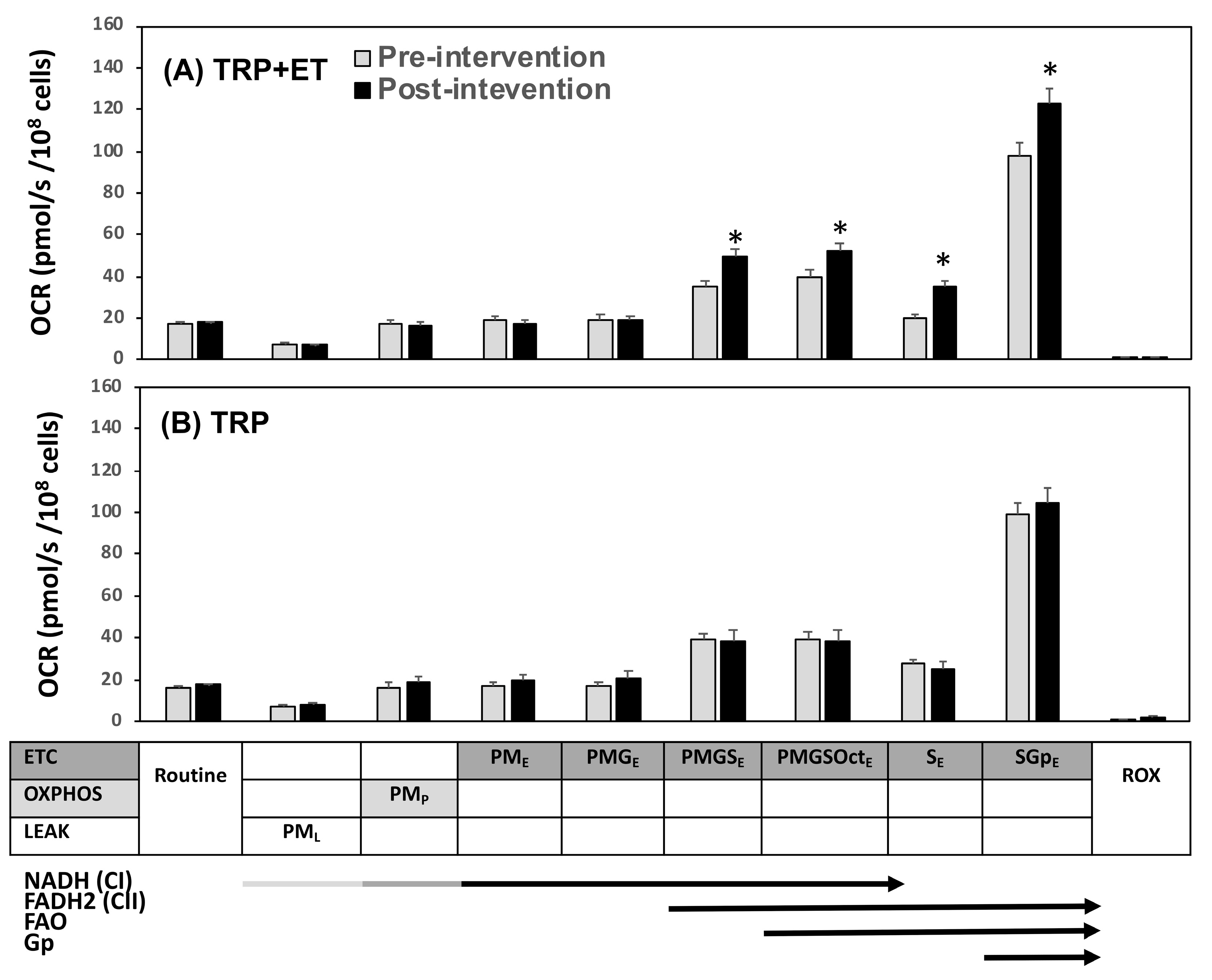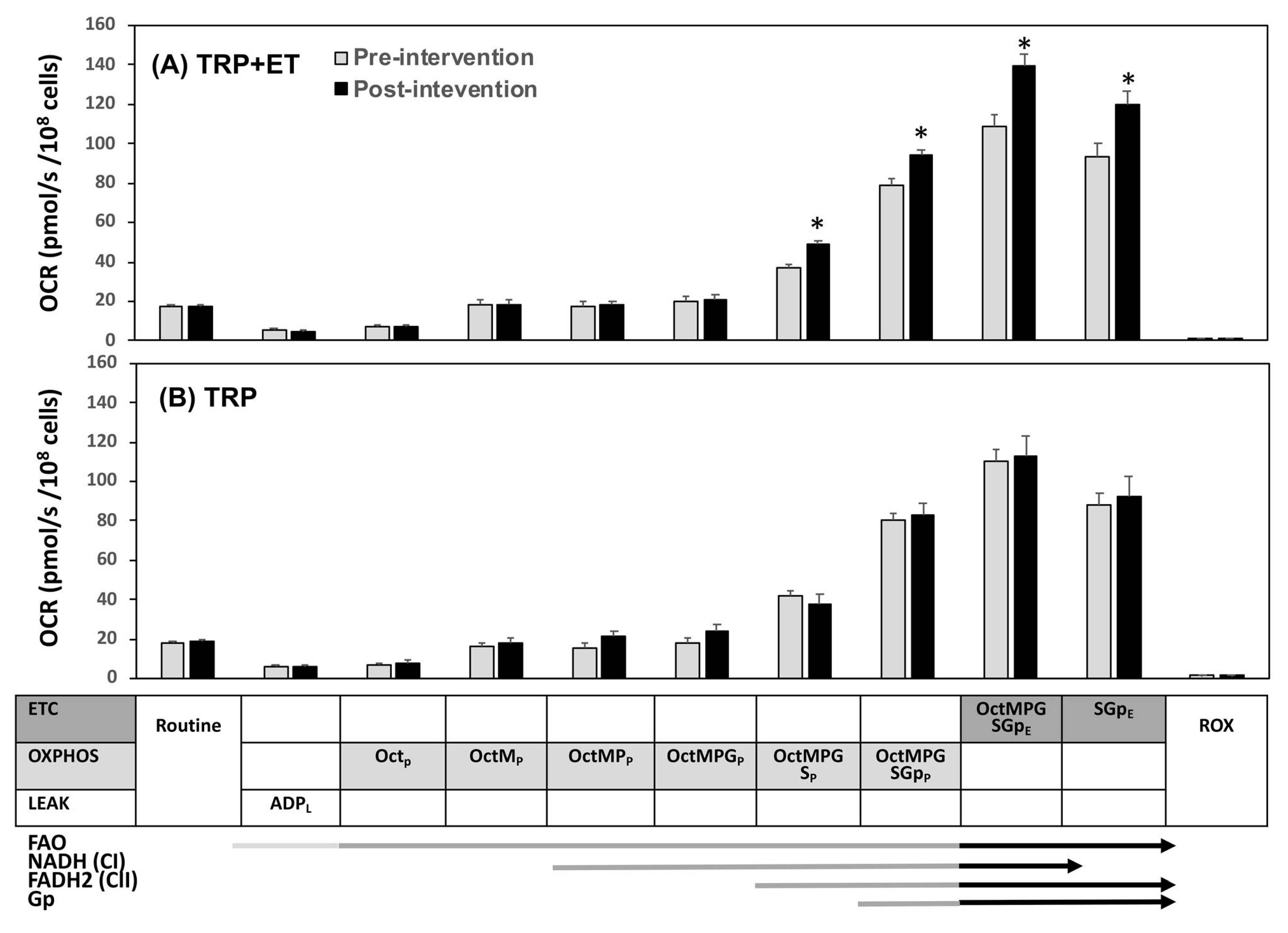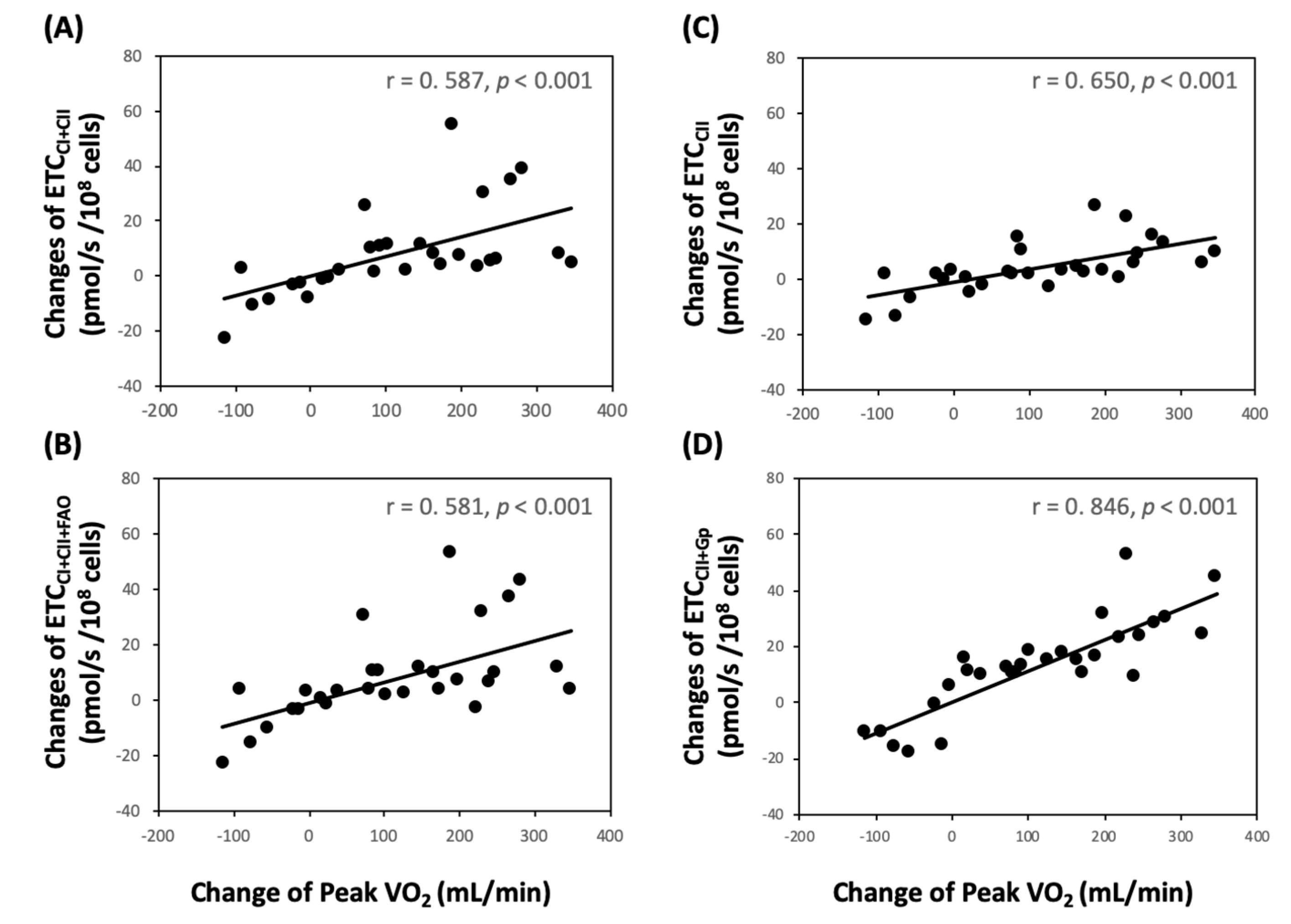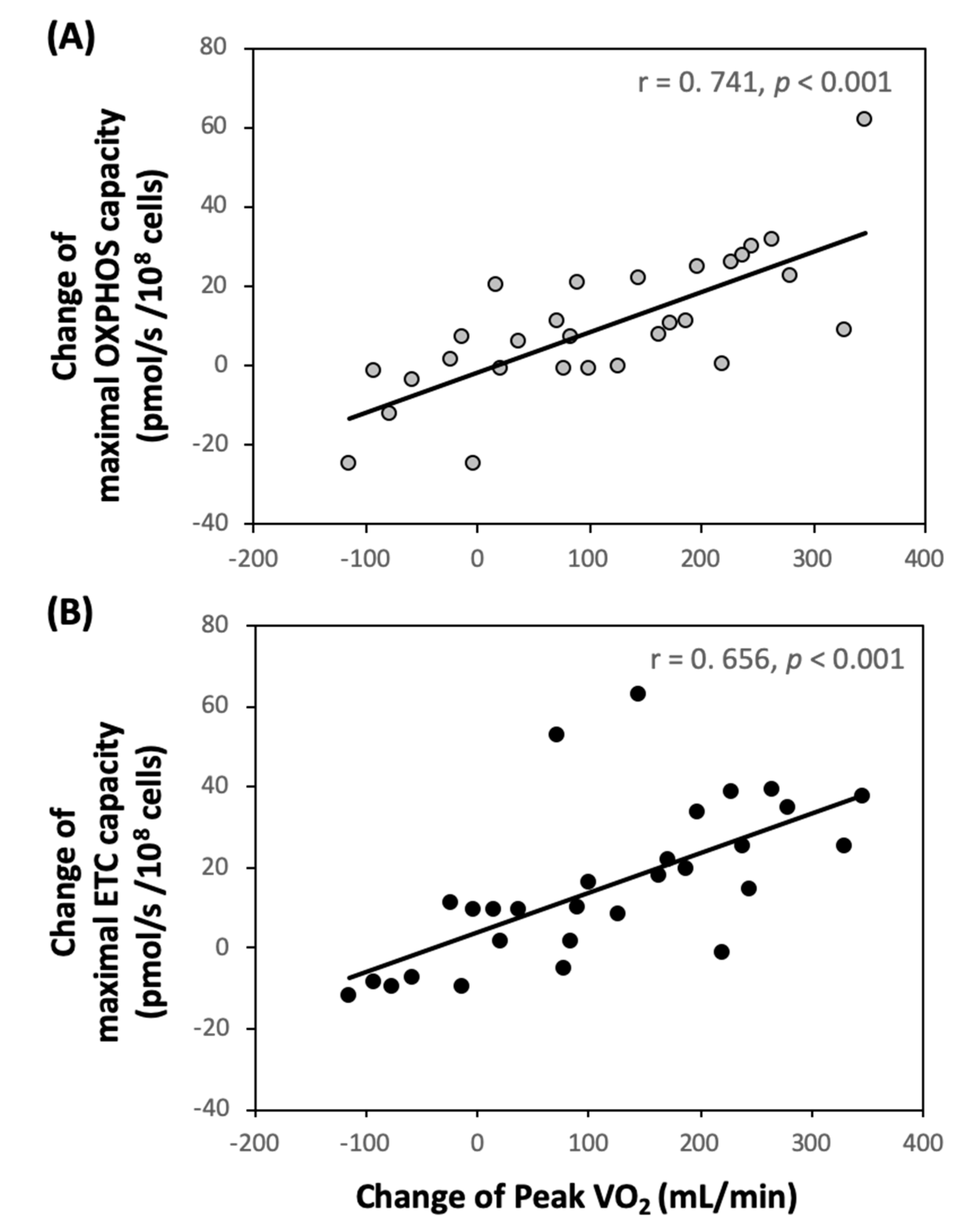Exercise Training Enhances Platelet Mitochondrial Bioenergetics in Stroke Patients: A Randomized Controlled Trial
Abstract
:1. Introduction
2. Methods
2.1. Participants
2.2. Graded Exercise Test (GET)
2.3. Cardiac Hemodynamic Measurements
2.4. Health-Related Quality of Life
2.5. Exercise Training (ET) Protocol
2.6. Blood Cell Count
2.7. Platelet Isolation
2.8. High-Resolution Respirometry
2.9. Mitochondrial ETC and OXPHOS in Platelets
2.10. Biomarkers of Oxidative Stress and Pro-Inflammation in Plasma
2.11. Statistical Analysis
3. Results
3.1. Cardiopulmonary Fitness and Health-Related QoL
3.2. Hematologic Parameters and Oxidative Stress/Inflammatory Biomarkers
3.3. Mitochondrial ETC and OXPHOS in Platelets
4. Discussion
4.1. Exercise Capacity
4.2. Mitochondrial Functionalities in Platelets
4.3. Health-Related Quality of Life
4.4. Limitations of This Study
5. Conclusions
Supplementary Materials
Author Contributions
Funding
Acknowledgments
Conflicts of Interest
References
- Meschia, J.F.; Bushnell, C.; Boden-Albala, B.; Braun, L.T.; Bravata, D.M.; Chaturvedi, S.; Creager, M.A.; Eckel, R.H.; Elkind, M.S.V.; Fornage, M.; et al. Guidelines for the primary prevention of stroke: A statement for healthcare professionals from the American Heart Association/American Stroke Association. Stroke 2014, 45, 3754–3832. [Google Scholar] [CrossRef] [PubMed] [Green Version]
- Feigin, V.L.; Lawes, C.M.; Bennett, D.A.; Anderson, C.S. Stroke epidemiology: A review of population-based studies of incidence, prevalence, and case-fatality in the late 20th century. Lancet Neurol. 2003, 2, 43–53. [Google Scholar] [CrossRef]
- Macko, R.F.; Ivey, F.M.; Forrester, L.W.; Hanley, D.; Sorkin, J.D.; Katzel, L.I.; Silver, K.H.; Goldberg, A.P. Treadmill exercise rehabilitation improves ambulatory function and cardiovascular fitness in Patients with chronic stroke: A randomized, controlled trial. Stroke 2005, 36, 2206–2211. [Google Scholar] [CrossRef] [PubMed]
- Han, P.; Zhang, W.; Kang, L.; Ma, Y.; Fu, L.; Jia, L.; Yu, H.; Chen, X.; Hou, L.; Wang, L. Clinical evidence of exercise benefits for stroke. Adv. Exp. Med. Biol. 2017, 1000, 131–151. [Google Scholar]
- Olney, S.J.; Nymark, J.; Brouwer, B.; Culham, E.; Day, A.; Heard, J.; Henderson, M.; Parvataneni, K. A randomized controlled trial of supervised versus unsupervised exercise programs for ambulatory stroke survivors. Stroke 2006, 37, 476–481. [Google Scholar] [CrossRef]
- Kotzailias, N.; Finsterer, J.; Zellner, M.; Marsik, C.; Dukic, T.; Jilma, B. Platelet function in mitochondriopathy with stroke and stroke-like episodes. Thromb. Haemost. 2004, 91, 544–552. [Google Scholar]
- Milionis, H.; Liontos, A.; Vemmos, K.; Spengos, K. Antiplatelet treatment in stroke: New insights. Curr. Pharm. Des. 2016, 22, 4617–4626. [Google Scholar] [CrossRef]
- Garcia-Souza, L.F.; Oliveira, M.F. Mitochondria: Biological roles in platelet physiology and pathology. Int. J. Biochem. Cell Biol. 2014, 50, 156–160. [Google Scholar] [CrossRef]
- Zharikov, S.; Shiva, S. Platelet mitochondrial function: From regulation of thrombosis to biomarker of disease. Biochem. Soc. Trans. 2013, 41, 118–123. [Google Scholar] [CrossRef]
- Kramer, P.A.; Chacko, B.K.; Ravi, S.; Johnson, M.S.; Mitchell, T.; Darley-Usmar, V.M. Bioenergetics and the oxidative burst: Protocols for the isolation and evaluation of human leukocytes and platelets. J. Vis. Exp. 2014, 85, e51301. [Google Scholar] [CrossRef] [Green Version]
- Wang, J.S. Exercise prescription and thrombogenesis. J. Biomed. Sci. 2006, 13, 753–761. [Google Scholar] [CrossRef] [PubMed] [Green Version]
- Wang, J.S.; Jen, C.J.; Chen, H.I. Effects of exercise training and deconditioning on platelet function in men. Arterioscler. Thromb. Vasc. Biol. 1995, 15, 1668–1674. [Google Scholar] [CrossRef] [PubMed]
- Wang, J.S.; Li, Y.S.; Chen, J.C. Effects of exercise training and deconditioning on platelet aggregation induced by alternating shear stress in men. Arterioscler. Thromb. Vasc. Biol. 2005, 25, 454–460. [Google Scholar] [CrossRef] [PubMed] [Green Version]
- Wu, L.H.; Chang, S.C.; Fu, T.C.; Huang, C.H.; Wang, J.S. High-intensity interval training improves mitochondrial function and suppresses thrombin generation in platelets undergoing hypoxic stress. Sci. Rep. 2017, 7, e4191. [Google Scholar] [CrossRef] [PubMed] [Green Version]
- Chou, C.H.; Fu, T.C.; Tsai, H.H.; Hsu, C.C.; Wang, C.H.; Wang, J.S. High-intensity interval training enhances mitochondrial bioenergetics of platelets in patients with heart failure. Int. J. Cardiol. 2019, 274, 214–220. [Google Scholar] [CrossRef]
- Wiedemann, F.R.; Vielhaber, S.; Schröder, R.; Elger, C.E.; Kunz, W.S. Evaluation of methods for the determination of mitochondrial respiratory chain enzyme activities in human skeletal muscle samples. Anal. Biochem. 2000, 279, 55–60. [Google Scholar] [CrossRef]
- Picard, M.; Taivassalo, T.; Ritchie, D.; Wright, K.J.; Thomas, M.M.; Romestaing, C.; Hepple, R.T. Mitochondrial structure and function are disrupted by standard isolation methods. PLoS ONE 2011, 6, e18317. [Google Scholar] [CrossRef]
- Letts, J.A.; Fiedorczuk, K.; Sazanov, L.A. The architecture of respiratory supercomplexes. Nature 2016, 537, 644–648. [Google Scholar] [CrossRef]
- Chacko, B.K.; Kramer, P.A.; Ravi, S.; Benavides, G.A.; Mitchell, T.; Dranka, B.P.; Ferrick, D.; Singal, A.K.; Ballinger, S.W.; Bailey, S.M.; et al. The Bioenergetic Health Index: A new concept in mitochondrial translational research. Clin. Sci. (Lond.) 2014, 127, 367–373. [Google Scholar] [CrossRef] [Green Version]
- Pesta, D.; Gnaiger, E. High-resolution respirometry: OXPHOS protocols for human cells and permeabilized fibers from small biopsies of human muscle. Methods Mol. Biol. 2012, 810, 25–58. [Google Scholar]
- Marnane, M.; Duggan, C.A.; Sheehan, O.C.; Merwick, A.; Hannon, H.; Curtin, D.; Harris, D.; Williams, E.B.; Horgan, G.; Kyne, L.; et al. Stroke Subtype classification to mechanism-specific and undetermined categories by TOAST, A-S-C-O, and causative classification system: Direct comparison in the North Dublin population stroke study. Stroke 2010, 41, 1579–1586. [Google Scholar] [CrossRef] [PubMed] [Green Version]
- American College of Sports Medicine. General principle of exercise prescription. In ACSM’s Guidelines for Exercise Testing and Prescription; Thompson, W.R., Gordon, N.F., Pescatello, L.S., Eds.; Lippincott Williams & Wilkins: Philadelphia, PA, USA, 2010; pp. 152–182. [Google Scholar]
- Arena, R.; Guazzi, M.; Myers, J. Ventilatory abnormalities during exercise in heart failure: A mini review. Curr. Respir. Med. Rev. 2007, 3, 179–187. [Google Scholar] [CrossRef]
- Hollenberg, M.; Tager, I.B. Oxygen uptake efficiency slope: An index of exercise performance and cardiopulmonary reserve requiring only submaximal exercise. J. Am. Coll. Cardiol. 2000, 36, 194–201. [Google Scholar] [CrossRef] [Green Version]
- ATS Committee on Proficiency Standards for Clinical Pulmonary Function Laboratories. ATS statement: Guidelines for the six-minute walk test. Am. J. Respir. Crit. Care Med. 2002, 166, 111–117. [Google Scholar] [CrossRef] [PubMed]
- Fu, T.C.; Wang, C.H.; Lin, P.S.; Hsu, C.C.; Cherng, W.J.; Huang, S.C.; Liu, M.H.; Chiang, C.L.; Wang, J.S. Aerobic interval training improves oxygen uptake efficiency by enhancing cerebral and muscular hemodynamics in patients with heart failure. Int. J. Cardiol. 2013, 167, 41–50. [Google Scholar] [CrossRef]
- Lai, S.M.; Perera, S.; Duncan, P.W.; Bode, R. Physical and social functioning after stroke: Comparison of the Stroke Impact Scale and Short Form-36. Stroke 2003, 34, 488–493. [Google Scholar] [CrossRef]
- Wang, J.S.; Jen, C.J.; Kung, H.C.; Lin, L.J.; Hsiue, T.R.; Chen, H.I. Different effects of strenuous exercise and moderate exercise on platelet function in men. Circulation 1994, 90, 2877–2885. [Google Scholar] [CrossRef] [Green Version]
- Petersen, A.M.; Pedersen, B.K. The anti-inflammatory effect of exercise. J. Appl. Physiol. 2005, 98, 1154–1162. [Google Scholar] [CrossRef] [Green Version]
- Khan, A.A.; Alsahli, M.A.; Rahmani, A.H. Myeloperoxidase as an active disease biomarker: Recent bioehcmical and pathological perspectives. Med. Sci. 2018, 6, 33. [Google Scholar] [CrossRef] [Green Version]
- Liu, F.; Lu, J.; Manaenko, A.; Tang, J.; Hu, Q. Mitochondria in ischemic stroke: New insight and implications. Aging Dis. 2018, 9, 924–937. [Google Scholar] [CrossRef] [Green Version]
- Basic Kes, V.; Simundic, A.M.; Nikolac, N.; Topic, E.; Demarin, V. Pro-inflammatory and anti-inflammatory cytokines in acute ischemic stroke and their relation to early neurological deficit and stroke outcome. Clin. Biochem. 2008, 41, 1330–1334. [Google Scholar] [CrossRef] [PubMed]
- Carter, H.N.; Chen, C.C.; Hood, D.A. Mitochondria, muscle health, and exercise with advancing age. Physiology (Bethesda) 2015, 30, 208–223. [Google Scholar] [CrossRef] [PubMed] [Green Version]
- Anzell, A.R.; Maizy, R.; Przyklenk, K.; Sanderson, T.H. Mitochondrial quality control and disease: Insights into ischemia-reperfusion injury. Mol. Neurobiol. 2018, 55, 2547–2564. [Google Scholar] [CrossRef] [PubMed] [Green Version]
- Mills, E.; O’Neill, L.A. Succinate: A metabolic signal in inflammation. Trends Cell. Biol. 2014, 24, 313–320. [Google Scholar] [CrossRef] [PubMed] [Green Version]
- Chouchani, E.T.; Pell, V.R.; Gaude, E.; Aksentijević, D.; Sundier, S.Y.; Robb, E.L.; Logan, A.; Nadtochiy, S.M.; Ord, E.N.J.; Smith, A.C.; et al. Ischaemic accumulation of succinate controls reperfusion injury through mitochondrial ROS. Nature 2014, 515, 431–435. [Google Scholar] [CrossRef] [PubMed] [Green Version]
- Woo, D.; Haverbusch, M.; Sekar, P.; Kissela, B.; Khoury, J.; Schneider, A.; Kleindorfer, D.; Szaflarski, J.; Pancioli, A.; Jauch, E.; et al. Effect of untreated hypertension on hemorrhagic stroke. Stroke 2004, 35, 1703–1708. [Google Scholar] [CrossRef] [Green Version]
- Perez, P.; Lukazewicz, A.C.; Lenck, S.; Nizard, R.; Drouet, L.; Payen, D. Platelet activation and aggregation after aneurysmal subarachnoid hemorrhage. BMC Neurol. 2018, 18, 57. [Google Scholar] [CrossRef] [Green Version]
- Chen, Y.W.; Chen, Y.C.; Fu, T.C.; Wang, C.H.; Huang, S.C.; Wang, J.S. Anemic comorbidity reduces capacity of endogenous thrombin generation and is associated with consumptive coagulopathy in patients with heart failure. Int. J. Cardiol. 2013, 168, 4965–4967. [Google Scholar] [CrossRef]




| TRP + ET | TRP | ||||
|---|---|---|---|---|---|
| Pre | Post | Pre | Post | ||
| Anthropometrics/Clinical Characteristics | |||||
| Gender | n (M/F) | 15 (12/3) | 15 (12/3) | 15 (13/2) | 15 (13/2) |
| Age | year | 55.7 ± 3.0 | - | 57.8 ± 3.9 | - |
| Height | cm | 165.7 ± 1.4 | 165.7 ± 1.4 | 166.8 ± 1.5 | 166.8 ± 1.5 |
| Weight | kg | 70.7 ± 2.7 | 70.0 ± 2.6 | 71.6 ± 2.8 | 72.2 ± 2.9 |
| BMI | kg/m2 | 25.8 ± 1.0 | 25.6 ± 0.9 | 25.7 ± 1.0 | 25.9 ± 1.2 |
| Heart rate | bpm | 76 ± 5 | 73 ± 6 | 77 ± 6 | 76 ± 7 |
| Systolic blood pressure | mmHg | 135 ± 10 | 132 ± 9 | 137 ± 9 | 136 ± 8 |
| Diastolic blood pressure | mmHg | 78 ± 4 | 75 ± 6 | 81 ± 5 | 80 ± 6 |
| Etiology | |||||
| Ischemia | n (%) | 12 (80) | - | 12 (80) | - |
| Small vessel thrombosis | 7 (47) | 8 (53) | |||
| Embolic | 5 (33) | 4 (27) | |||
| Hemorrhage | n (%) | 3 (20) | - | 3 (20) | - |
| Stroke duration | month | 21 ± 3 | - | 23 ± 4 | - |
| Brunnstrom Stage | |||||
| Stage III | n (%) | 3 (25) | - | 4 (27) | - |
| >Stage III | n (%) | 12 (75) | - | 11 (73) | - |
| Mini-Mental State Examination | |||||
| score | 28.7 ± 2.9 | - | 29.2 ± 4.5 | - | |
| Risk Factors | |||||
| Smoking | n (%) | 6 (40) | 6 (40) | ||
| Hyperlipidemia | n (%) | 12 (80) | - | 11 (73) | - |
| Hypertension | n (%) | 3 (20) | - | 4 (27) | - |
| CVD | n (%) | 7 (47) | - | 8 (53) | - |
| Diabetes mellitus | n (%) | 10 (67) | - | 9 (60) | - |
| Hematological Parameters | |||||
| Erythrocyte | 106/μL | 5.00 ± 0.12 | 5.17 ± 0.14 | 4.91 ± 0.11 | 4.90 ± 0.16 |
| Hemoglobin | g/dL | 14.3 ± 0. 4 | 14.8 ± 0.5 | 14.2 ± 0. 4 | 14.2 ± 0.7 |
| Hematocrit | % | 44.6 ± 1.3 | 45.7 ± 1.4 | 44.3 ± 1.3 | 43.1 ± 1.9 |
| Leukocyte | 103/μL | 7.01 ± 0.21 | 6.72 ± 0.40 | 7.17 ± 0.26 | 6.37 ± 0.53 |
| Platelet | 103/μL | 264 ± 13 | 239 ± 16 | 274 ± 15 | 255 ± 12 |
| Plasma Oxidative Stress and Pro-Inflammatory Status | |||||
| MPO | ng/mL | 11.70 ± 0.64 | 8.38 ± 1.05 * | 11.10 ± 0.98 | 12.15 ± 0.82 |
| IL-6 | pg/mL | 13.69 ± 1.75 | 9.61 ± 1.75 * | 13.09 ± 1.84 | 13.03 ± 1.73 |
| Medicines | |||||
| ASA | n (%) | 7 (47) | 7 (47) | 8 (53) | 8 (53) |
| NOAC | n (%) | 5 (33) | 5 (33) | 4 (27) | 4 (27) |
| HMG CoA reductase inhibitor | n (%) | 12 (80) | 12 (80) | 11 (73) | 11 (73) |
| β-blockers | n (%) | 3 (20) | 3 (20) | 4 (27) | 4 (27) |
| ACEI/ARB | n (%) | 3 (20) | 3 (20) | 4 (27) | 4 (27) |
| TRP + ET | TRP | ||||
|---|---|---|---|---|---|
| Pre | Post | Pre | Post | ||
| Peak Exercise Performance | |||||
| Work-rate | watt | 81.9 ± 4.8 | 100.0 ± 6.1 * | 78.8 ± 7.8 | 80.5 ± 6.9 |
| Hear rate | bpm | 132 ± 4 | 139 ± 3 * | 133 ± 4 | 134 ± 5 |
| Stroke volume | mL | 68.1 ± 3.2 | 80.5 ± 4.1 * | 70.8 ± 3.5 | 75.7 ± 3.7 |
| Cardiac output | L/min | 8.97 ± 0.41 | 11.16 ± 0.79 * | 9.42 ± 0.52 | 10.15 ± 0.91 |
| VE | L/min | 50.3 ± 3.1 | 62.5 ± 3.7 * | 51.2 ± 4.1 | 53.4 ± 5.2 |
| VO2 | mL/min | 1155 ± 80 | 1359 ± 85 * | 1165 ± 76 | 1194 ± 65 |
| VCO2 | mL/min | 1291 ± 87 | 1590 ± 97 * | 1348 ± 92 | 1395 ± 95 |
| MET | score | 4.7 ± 0.2 | 5.5 ± 0.2 * | 4.6 ± 0.3 | 4.8 ± 0.2 |
| OUES | unit | 630 ± 38 | 831 ± 58 * | 634 ± 61 | 575 ± 36 |
| VE-VCO2 slope | unit | 35.3 ± 1.9 | 32.6 ± 2.2 | 34.6 ± 1.9 | 34.3 ± 1.5 |
| 6-min walk test | meter | 325.4 ± 76.2 | 380.4 ± 47.4 * | 320.5 ± 62.1 | 315.6 ± 56.3 |
| Short Form-36 Health Survey Questionnaire | |||||
| Physical | score | 40.1 ± 1.7 | 44.2 ± 2.0 * | 41.5 ± 2.1 | 40.6 ± 2.2 |
| Mental | score | 36.1 ± 2.1 | 44.9 ± 2.2 * | 36.8 ± 2.2 | 34.8 ± 2.7 |
© 2019 by the authors. Licensee MDPI, Basel, Switzerland. This article is an open access article distributed under the terms and conditions of the Creative Commons Attribution (CC BY) license (http://creativecommons.org/licenses/by/4.0/).
Share and Cite
Hsu, C.-C.; Tsai, H.-H.; Fu, T.-C.; Wang, J.-S. Exercise Training Enhances Platelet Mitochondrial Bioenergetics in Stroke Patients: A Randomized Controlled Trial. J. Clin. Med. 2019, 8, 2186. https://doi.org/10.3390/jcm8122186
Hsu C-C, Tsai H-H, Fu T-C, Wang J-S. Exercise Training Enhances Platelet Mitochondrial Bioenergetics in Stroke Patients: A Randomized Controlled Trial. Journal of Clinical Medicine. 2019; 8(12):2186. https://doi.org/10.3390/jcm8122186
Chicago/Turabian StyleHsu, Chih-Chin, Hsing-Hua Tsai, Tieh-Cheng Fu, and Jong-Shyan Wang. 2019. "Exercise Training Enhances Platelet Mitochondrial Bioenergetics in Stroke Patients: A Randomized Controlled Trial" Journal of Clinical Medicine 8, no. 12: 2186. https://doi.org/10.3390/jcm8122186
APA StyleHsu, C.-C., Tsai, H.-H., Fu, T.-C., & Wang, J.-S. (2019). Exercise Training Enhances Platelet Mitochondrial Bioenergetics in Stroke Patients: A Randomized Controlled Trial. Journal of Clinical Medicine, 8(12), 2186. https://doi.org/10.3390/jcm8122186





